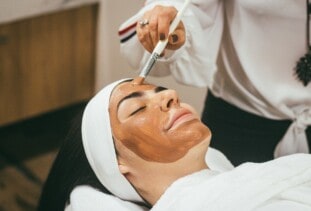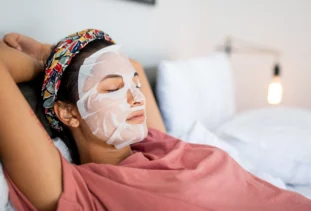Most people would benefit from getting a facial treatment once a month. Unless you’re using a specific treatment to deal with a particular skin issue, more than once per month tends to be excessive, while anything past six months leaves the door open to developing new skin concerns.
There is no hard-and-fast rule for how often you should get a facial, especially since there are so many different types of facials with different recommended timelines. However, there are some general guidelines to follow based on factors like your skin type and age.
Below, we cover how often to get a facial based on skin concerns and common questions to help you get esthetician-quality skin.
| Skin Concern | Type of Facial | Frequency |
|---|---|---|
| Breakouts and blemishes | Classic, decongesting, microdermabrasion, LED light | Every two weeks until clear, followed by every month |
| Dry and flaky | Gentle exfoliation, moisturizing mask, HydraFacial | Every two weeks until hydrated, followed by every month |
| Oily | Chemical peel, extraction, glycolic/salicylic acid exfoliation | Every month |
| Dry and oily (combination) | Enzyme exfoliant, chemical peel, microdermabrasion, extraction | Every month |
| Wrinkles/aging | Chemical peels, microneedling, oxygen | Every month |
| Hyperpigmentation | Enzyme exfoliant, HydraFacial, laser treatment | Every month until even, followed by every four to six months |
| Sensitive | Soothing, restorative, LED light | Every two months |
| Maintenance | Chemical peel, deep cleanse | Every two to six months |
Once every two weeks
If you’re struggling with acne flare-ups, clogged pores, or excessively dry skin, your esthetician may recommend more frequent facials. In this case, schedule a facial every two weeks until your skin is clean and clear, and then every one to two months after to maintain it.
Typically, your esthetician will suggest a relatively gentle treatment based on your specific skin concerns, such as a light chemical peel or microdermabrasion.
You should get a facial once every two weeks if your skin concerns include:
- Acne breakouts or dry, damaged skin: People with sudden or constant skin flare-ups may need more frequent facials to get the issue under control.
Once a month
For those with skin on either end of the oily/dry spectrum, getting a monthly facial is quite normal. This facial routine schedule is best suited for those who don’t have a particular issue they need to address but who need some extra help getting their skin to cooperate.
Dermaplaning and microneedling are both good examples of professional facial treatments that can be done once a month to address a more generalized skin issue. While dermaplaning is better for removing dry skin, microneedling is excellent for stimulating collagen growth, making it a good monthly option for oily skin.
You should get a facial once a month if your skin concerns include:
- Dry skin: If you have dry, dull skin in need of hydration and brightening, a facial that includes gentle exfoliation and a deep penetrating mask will help remove dead skin cells and restore lost moisture.
- Oily skin: People with oily skin are typically in a constant battle with clogged pores and breakouts. If this sounds like you, treatments that include an exfoliant, like salicylic or glycolic acid, will help decongest pores.
- Combination skin: Because combination skin has both dry and oily areas, each area will need to be treated differently. For this type of skin, plan to schedule a facial once a month to keep your acne-prone areas in check without agitating your drier areas.
- Aging skin: Older skin takes longer to rejuvenate compared to younger skin, so if you’re over the age of 50 you may want to schedule a light therapy treatment or chemical peel once a month to stimulate collagen production and cell turnover.
- Hyperpigmentation: Your esthetician can treat sun damage or melasma with light therapy treatments. These are typically done every three to four weeks for the first few sessions and can be spread out longer once the issue is under control.
Every two months
For those who have met their skin goals by establishing a quality facial/skin care routine with a skin care expert, a facial every two months is standard. Those who receive facials at this frequency are working on maintaining their current skin condition as more general upkeep.
One example of this might be getting an oxygen facial every 90 days or so. Oxygen facials are noninvasive and don’t require much prep or aftercare, making them a great option for those looking to keep their skin cleansed and vibrant.
You should get a facial every two months if your skin concerns include:
- Sensitive skin: If your skin is sensitive to exfoliants and chemicals, you may need more time between treatments to give your skin adequate time to adjust and repair itself.
- Maintenance: Once you’ve conquered your skin goals, your priority will likely be maintaining a clean, clear complexion. A regular exfoliant or deep cleanse will keep your skin vibrant and blemishes at bay.
Every six months
For those with excellent skin who don’t necessarily have any skin concerns, a facial every six months may be enough to keep it healthy and vibrant. Six months is the maximum amount of time you should go between facial treatments if you want to maintain your skin health.
An example of a twice-yearly treatment might be a chemical peel to tighten pores and bring new skin to the surface. Chemical peels are most effective when they’re not done with great frequency, so for someone with naturally great skin, a chemical peel every six months is a great option to remove dead skin cells and encourage healthy cell turnover.
You should get a facial every six months if your skin concerns include:
- Maintenance: If you’re not looking to treat a specific skin concern, twice-yearly treatments will keep your skin glowing. Intense or invasive treatments like chemical peels are more effective when spaced out longer, giving your skin ample recovery time.
Considerations for your facial
Skin type and the type of facial treatment will predominantly dictate the frequency of your professional facial appointments. When determining the best facial routine for your skin, you and your esthetician should consider the following:
Your skin type
Whether you have normal, oily, dry, or combination skin, your skin type is a determining factor for how often you should get a professional facial. Skin type is determined by genetics that impact your skin’s balance, such as:
- Sebaceous (oil) secretion
- Hydration
- Sensitivity level
Skin type doesn’t just help establish how often you should get a facial; it also helps determine what kind of facial will be most effective for your specific needs.
Your skin condition
The condition of your skin is determined by what your skin is doing right at this moment. Perhaps you have a history of great skin, but a change in your diet or lifestyle may be causing you to break out.
Whether it’s a new medication, stress, or even a completely unknown factor changing the appearance of your skin, the current condition matters when establishing a new facial routine.
Your skin goals
Determining what you want out of your facial routine is vital for figuring out how frequently you should seek facial treatments. If your goals are lofty, then frequency may increase as the treatment permits.
Alternatively, if you’re simply looking to maintain your current skin condition, then you may not need treatment as often. Here’s a general guideline for facial frequency based on skin goals, although this will vary based on your skin type and treatment of choice.
- Moisturize and hydrate: once a month
- Declog and clear: every two weeks until clear, followed by once a month
- Even out: once a month until even, followed by once every four to six months
- Exfoliate: once a month
- Brighten: once a month or once every two months
- Rejuvenate: once a month
- Maintain: once every two months
When discussing your skin goals with your skin care professional, it’s important to keep your expectations realistic. Your esthetician will help you establish which treatment is right for you, how often you should have it done, and what you should anticipate from your new facial routine.
Your facial treatment of choice
Certain types of facial treatments require more time between sessions than others. Typically, if your facial treatment cleanses the skin by removing layers, there needs to be substantial time between treatments.
- Classic facials: Every two weeks or once a month
- Microdermabrasion: Once a month
- Light chemical peel: Once a month
- Medium or deep peels: Once every six months
- Laser treatments: Once a month
- LED facials: Once a week for one month, followed by once every two months
- Firming or sculpting facials: Once every three to four months
- Lymphatic facial: Once every three months
- Deep cleaning facial: Once a month
Again, these are general guidelines that may or may not be right for you. For a more personalized approach, schedule a proper skin care consultation with a certified esthetician to determine the best treatment and frequency of treatments based on your skin.
Your age
Younger skin rejuvenates faster than older skin, so people over the age of 50 should consider scheduling their facials more frequently. In teenagers and younger adults, skin renews itself every 28-42 days, while the skin renewal process may take twice as long for those over 50. As we age, it takes longer for our skin to repair and replace damaged cells, resulting in more built-up skin cells and a dull, tired complexion.
Regular chemical peels, microneedling, and oxygen facials once a month will help promote collagen production and reverse the signs of aging.
Your budget
Budget is the final determining factor when establishing a new facial routine. Facials tend to be expensive, so it’s important to be realistic about what you can afford and how much you’re willing to spend on a facial.
Again, working with a skin care professional will help you establish a budget and what can be accomplished within those boundaries. No matter where you’re located, you can find a qualified esthetician to help you maximize your results on a minimal budget.
Facial practices for best results
When developing a new facial routine, there are some considerations to keep in mind. Factors like the kind of facial you get, the cost, and even the availability of that treatment in your area will influence things like frequency, prep, and aftercare. Follow these facial best practices to ensure you’re getting the most from your skin care routine:
- Work with a certified esthetician to determine which facial treatment is best for your skin goals.
- Set realistic and reasonable goals — it’s possible (and completely normal!) that your complexion just won’t allow for completely flawless skin. But it is very likely that your skin will improve drastically.
- Experiment safely under the supervision of your esthetician. There are lots of different facial routines out there, and sometimes the best way to know if something works is to give it a shot!
Once you’ve enlisted the help of a professional, figured out what works, and decided on the frequency of treatment, you’re ready to establish your new facial routine! The next step is simply finding where to get a facial based on your specific skin care needs.
Facial frequency FAQs
The results of a standard facial last about four to six weeks for most skin types. However, this will vary depending on the type of facial treatment and thes steps you take to maintain your results post-treatment. To make your results last as long as possible, ask for detailed aftercare instructions from your esthetician.
While at-home facials are a great self-care activity that can help relieve stress, don’t expect the same results you’d get from a professional treatment. Professional facials include top-of-the-line products, equipment, and, most importantly, a skilled esthetician to do the work — you simply can’t recreate this experience with store-bought products and beauty tools.
There are dozens of different facial treatments that can be fine-tuned to address any specific skin care concern, from eczema to forehead wrinkles. Some of the most popular treatments include microdermabrasion, chemical peels, lymphatic massages, and dermaplaning.
It’s typically recommended to schedule a facial once a month to keep your skin glowing and healthy. However, there is no set rule for how frequently you should get a facial — frequency will ultimately depend on your skin type, current condition, goals, treatment type, age, and budget. Talk to a certified esthetician to determine what routine is right for you.
Schedule your first facial to start seeing results
How often you should get a facial depends on several factors, including your skin type and skin concerns. Now that you have an understanding of facial frequency, it’s time to book a skin care consultation with the right beauty professionals in your area. StyleSeat can easily and quickly connect you to an experienced esthetician to help make your skin care goals a reality.






